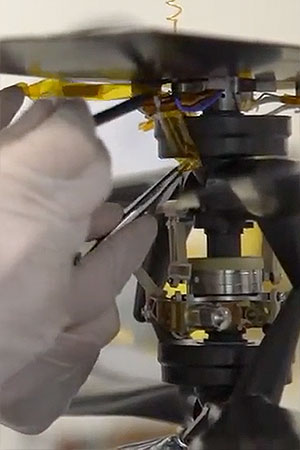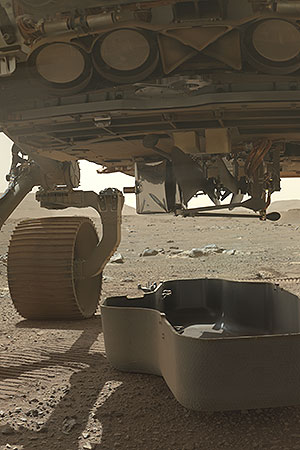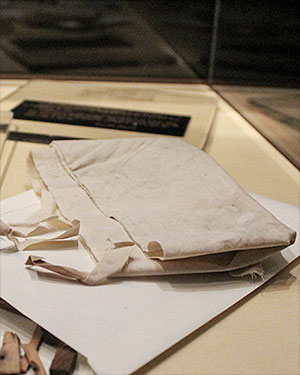March 29, 2021 — A small swatch of fabric is set to take flight on a first-of-its-kind aircraft more than a century, and a world away, from where it first made history.
The strip of muslin, which was once part of a wing on the Wright brothers' 1903 Flyer — the first successful heavier-than-air powered aircraft — is now on Mars, affixed to Ingenuity, the first aircraft to attempt powered flight on another planet.
"This fabric is from the original aircraft that flew at Kitty Hawk," said Bob Balaram, chief engineer for NASA's Ingenuity Mars helicopter. "With all our high tech materials and carbon fiber skins and exotic metals, we're very proud to honor that experimental aircraft from long ago by carrying a small piece of [its] fabric."
The Flyer fabric is wrapped around a cable located underneath the helicopter's solar panel, held in place by insulative tape.
Ingenuity, which landed on Mars with the Perseverance rover, is intended as a technology demonstrator. If successful, the helicopter could lead to future aircraft assisting robotic and human missions on the Red Planet.
"It is in the long tradition of experimental aircraft that started all the way from the Wright brothers, who were able to bring aerial mobility as a dimension for us to be able to travel here on Earth. In the same way, we are hoping that Ingenuity also allows us to expand and open up aerial mobility on Mars," said Balaram in a press conference held March 23 at the Jet Propulsion Laboratory (JPL) in California.
First flights
The Wright Flyer ushered in the aerial age on Earth with a 12-second flight on Dec. 17, 1903. With Orville Wright as its pilot and Wilbur Wright running alongside, the Flyer traveled 120 feet (36 meters) over the sand-covered Outer Banks of North Carolina.
The Flyer made three more flights that day before it was damaged beyond repair. It was later restored and is displayed by the Smithsonian's National Air and Space Museum in Washington, DC.
The Ingenuity Mars helicopter is slated to attempt its first flight on or about April 8, after it has been deployed by Perseverance within a flat area of Jezero crater that will serve as its airfield. Like the Flyer, the first flight of the rotor-powered Ingenuity will be brief. If all goes to plan, the helicopter will ascend to 10 feet (3 meters) high and hover for up to 30 seconds before turning and touching down.
Controlled flight is difficult to achieve on Mars. The planet's gravity is about one-third that of Earth's, but its atmosphere is just one percent as dense at the surface.
"The first flight is special. It is by far the most important flight that we plan to do," said Håvard Grip, Ingenuity's chief pilot at JPL. "We will declare complete mission success if we do this first flight that we're going to attempt."
Ingenuity's on board avionics will take the place of Orville Wright as pilot, but like Wilbur, Perseverance will be watching from the side. The rover will receive data and possibly film the helicopter's flight from "Van Zyl Overlook," an area named for Jakob van Zyl, a leader of solar system exploration at JPL, who unexpectedly died about a month after Perseverance and Ingenuity launched to Mars.
Far-flung Flyer fabric
It was Orville Wright who removed the Flyer fabric that is now on board Ingenuity. He was preparing the aircraft for its first public exhibition when the "Pride of the West" unbleached muslin was replaced in 1916. Later, he and his brother found another use for the material.
"The Wright brothers were auctioning pieces of it to raise money for their future efforts," said Balaram.
NASA worked with Carillon Historical Park, home to the Wright Brothers National Museum, to source the fabric.
"Our mission includes 'inspiring the world.' We hope this partnership with NASA helps do just that — inspiring our world by reaching beyond it," said Brady Kress, president of Carillon Historical Park, in a statement.
This is not the first time that fabric from the Wrights' 1903 Flyer has left Earth. In 1969, the Wright family gave Apollo 11 astronaut Neil Armstrong pieces of the muslin and a splinter of wood from the plane's left propeller to fly on the first moon landing mission.
Fragments of the lunar-flown Flyer artifacts are now on exhibit at museums across the U.S. and in private collections, the latter after being auctioned for as much as $275,000.
A different piece of the 1903 Flyer's fabric flew aboard the space shuttle Discovery, accompanying former Mercury astronaut John Glenn on his 1998 return to orbit.
The same orbiter, Discovery, lofted yet another fragment of the first airplane two years later on behalf of North Carolina's First Flight Centennial Commission. The muslin, which was flown to the International Space Station, was launched in celebration of the then-upcoming 100th anniversary of the Flyer and STS-92, the 100th space shuttle mission.
Now, Flyer fabric has not just reached Mars, but is ready to take a history-making flight... again.
"Wilbur and Orville Wright would be pleased to know that a little piece of their 1903 Wright Flyer I, the machine that launched the Space Age by flying barely one quarter of a mile, is going to soar into history again on Mars!" Amanda Wright Lane and Stephen Wright, Wilbur and Orville's great grand-niece and nephew, said in a statement. "The NASA Mars Perseverance team has found a way to coax another 330 million miles [530 million km] out of the original Pride of the West fabric that Wilbur and Orville thought they retired from their Flyer's broken wings on Dec. 17, 1903." |
|

A small swatch of the muslin that covered one of the wings of the Wright brothers' Flyer during its first flight in 1903 is affixed to the Ingenuity Mars helicopter. An insulative tape was used to wrap the small piece of fabric around a cable located under the helicopter's solar panel. (NASA/JPL-Caltech)

NASA's Ingenuity helicopter is seen exposed on the underbelly of the Perseverance rover after its debris shield was released on Mars on March 21, 2021. (NASA/JPL-Caltech/MSSS)

"Pride of the West" muslin that once covered the Wright Flyer for its first flight at Kitty Hawk on Dec. 17, 1903. (Carillon Historical Park) |
